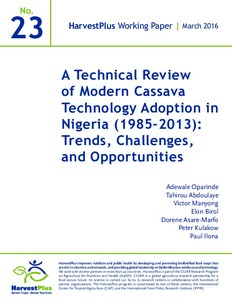| dc.contributor.author | Oparinde, A. |
| dc.contributor.author | Abdoulaye, Tahirou |
| dc.contributor.author | Manyong, Victor M. |
| dc.contributor.author | Birol, E. |
| dc.contributor.author | Asare-Marfo, Dorene |
| dc.contributor.author | Kulakow, P.A. |
| dc.contributor.author | Ilona, P. |
| dc.date.accessioned | 2019-12-04T11:03:40Z |
| dc.date.available | 2019-12-04T11:03:40Z |
| dc.date.issued | 2016-03 |
| dc.identifier.citation | Oparinde, A., Abdoulaye, T., Manyong, V., Birol, E., Asare-Marfo, D., Kulakow, P. & Ilona, P. (2016). A technical review of modern cassava technology adoption in Nigeria (1985-2013): Trends, challenges, and opportunities (HarvestPlus working paper No. 23). Washington, D.C.: International Food Policy Research Institute |
| dc.identifier.uri | https://hdl.handle.net/20.500.12478/1190 |
| dc.description.abstract | In recent times, results of various adoption studies have been mixed, raising questions regarding why some improved farm technologies are still not widely adopted several years after their first introduction. Many improved cassava varieties have been introduced to millions of farm households across Africa south of the Sahara. Using an extensive review of cassava-adoption literature focused on Nigeria, this paper discusses the uptake of improved cassava varieties. Generic measurement and methodological issues in the literature are illuminated and alternative approaches suggested. The literature can be improved to better inform policy by considering issues such as attribution constraint due to varietal identification challenges and sample selection bias that can limit interpretation of findings. Very few studies disaggregated adoption by men and women, thus the literature can provide more policy relevance by giving adequate attention to gender considerations. Also, the use of only descriptive statistics and dichotomous choice models is most common while issues of sequencing, simultaneity, endogenity, and social learning effects in adoption decisions are under-evaluated. The local germplasm at research institutions in the country is not exhaustive and thus efforts should focus on improving the database for an effective use of a DNA fingerprinting technique in the varietal identification process. |
| dc.format.extent | 24 p. |
| dc.language.iso | en |
| dc.publisher | International Food Policy Research Institute |
| dc.relation.ispartofseries | ;23 |
| dc.subject | Cassava |
| dc.subject | Varieties |
| dc.subject | Retinol |
| dc.subject | Carotenoids |
| dc.title | A technical review of modern cassava technology adoption in Nigeria (1985-2013): trends, challenges, and opportunities: HarvestPlus working paper, No. 23 |
| dc.type | Book |
| cg.contributor.crp | Roots, Tubers and Bananas |
| cg.contributor.affiliation | International Food Policy Research Institute |
| cg.contributor.affiliation | International Institute of Tropical Agriculture |
| cg.contributor.affiliation | HarvestPlus |
| cg.coverage.region | Africa |
| cg.coverage.region | Africa South Of Sahara |
| cg.coverage.region | West Africa |
| cg.coverage.country | Nigeria |
| cg.authorship.types | CGIAR multi-centre |
| cg.iitasubject | Cassava |
| cg.howpublished | Formally Published |
| cg.publicationplace | Washington, D.C. |
| cg.accessibilitystatus | Limited Access |
| local.dspaceid | 78385 |
| cg.targetaudience | Scientists |

